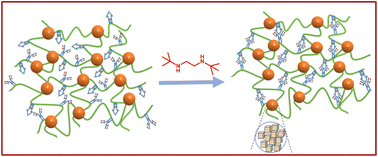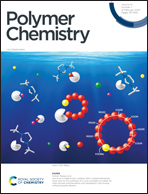Crosslinking of poly(n-butyl acrylate)-POSS copolymers via dynamic urea exchange enables self-healing, reprocessing and shape recovery†
Abstract
In this contribution, we reported a novel approach to crosslink linear poly(n-butyl acrylate)-POSS copolymers via a dynamic urea exchange reaction. First, the linear copolymers of n-butyl acrylate, POSS acrylate and 2-(3-(tert-butyl)-3-methylureido)ethylacrylate were synthesized via radical reversible addition–fragmentation chain transfer (RAFT) polymerization. Of these copolymerization monomers, 2-(3-(tert-butyl)-3-methylureido)ethylacrylate was synthesized by the reaction of 2-isocyanatoethyl acrylate with N-tert-butylmethylamine (i.e., a hindered monoamine); it carries a single hindered urea bond (HUB). Owing to the introduction of 2-(3-(tert-butyl)-3-methylureido)ethylacrylate structural units, the linear copolymers can be further crosslinked with 1,2-bis(tert-butyl)ethylenediamine (viz. a hindered diamine) via a dynamic urea exchange reaction. In the dynamic urea exchange reaction, every two 2-(3-(tert-butyl)-3-methylureido)ethylacrylate structural units reacted with one 1,2-bis(tert-butyl)ethylenediamine, generating one chemical linkage bearing two HUBs. The crosslinking of the linear copolymers with HUBs enabled the self-healing and/or reprocessing of the organic–inorganic networks. In addition, the organic–inorganic nanocomposites displayed excellent thermally-induced shape memory properties due to the generation of networks. Furthermore, the original shapes of the shape memory polymers can be re-edited by utilizing the dynamic exchange of HUBs.



 Please wait while we load your content...
Please wait while we load your content...